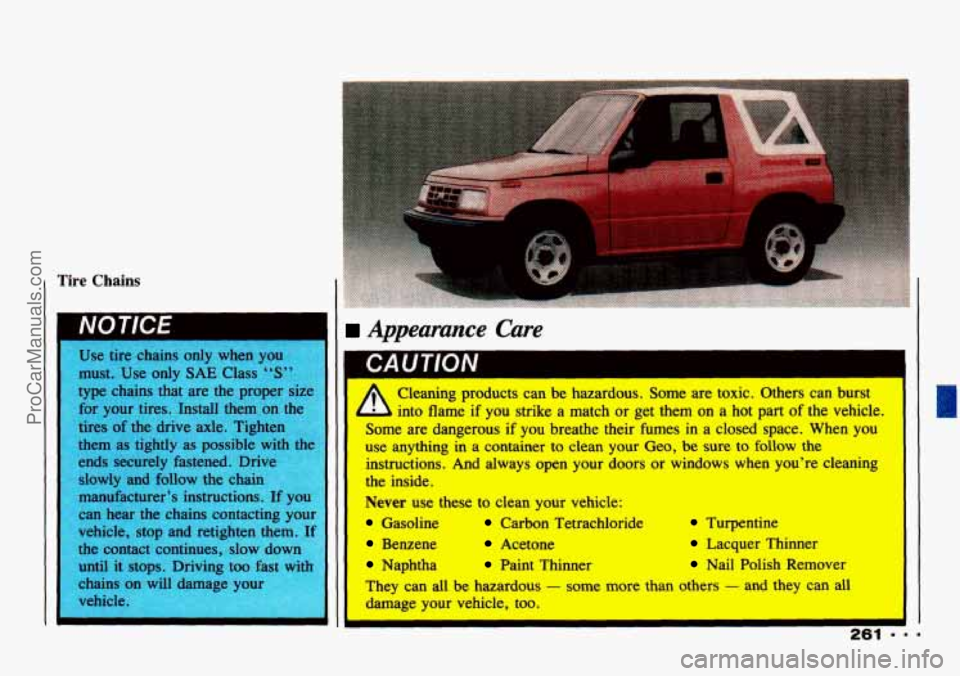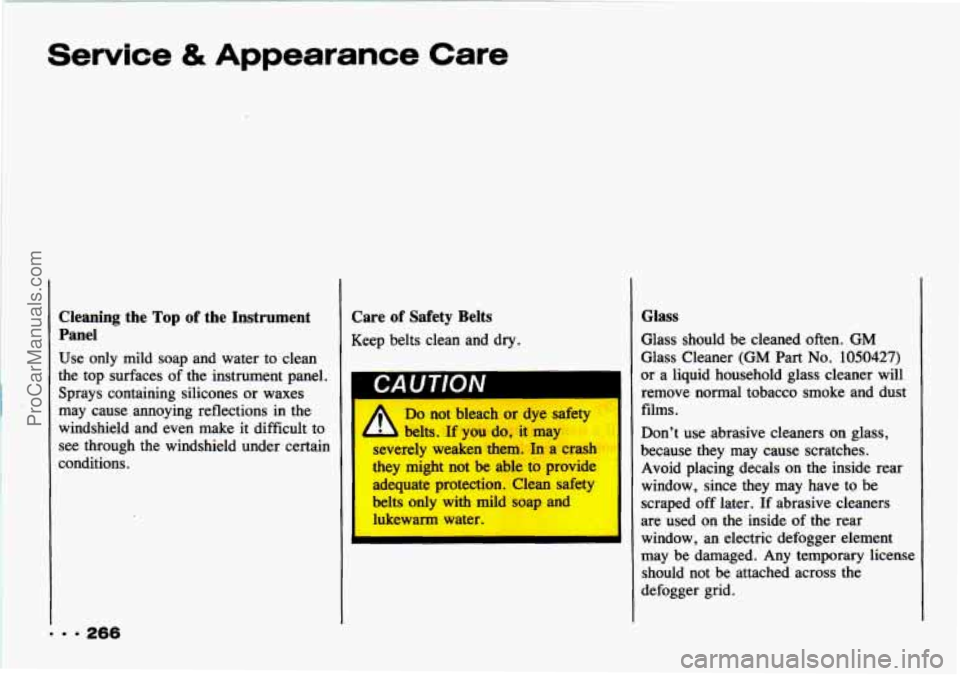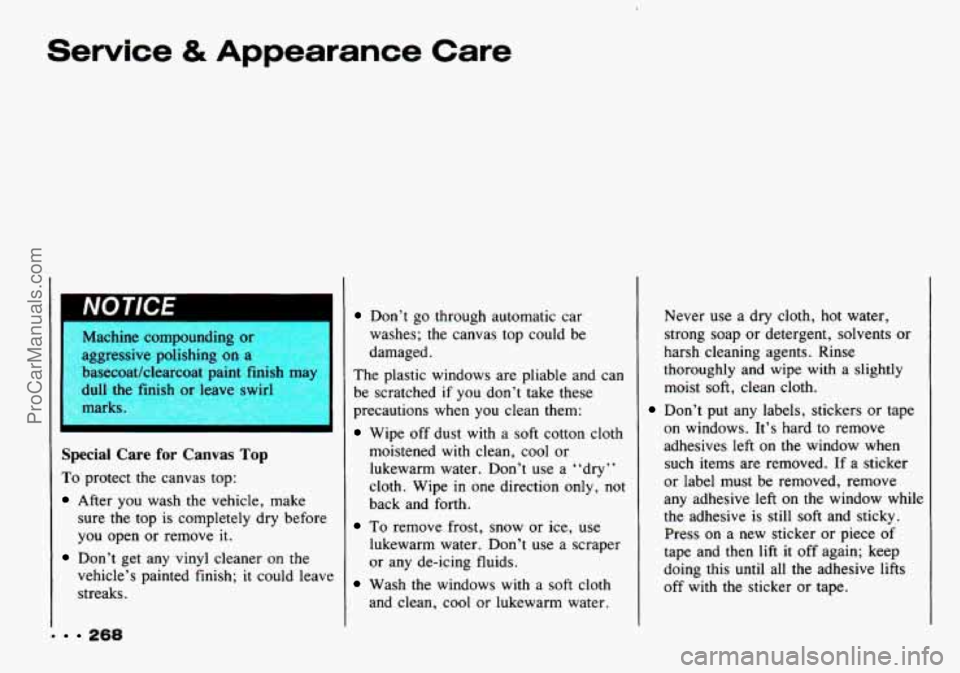1993 CHEVROLET TRACKER window
[x] Cancel search: windowPage 178 of 339

Your Driving and the Road
.._
176
If you have no blankets or extra
clothing, make body insulators from
newspapers, burlap bags, rags, floor
mats
- anything you can wrap around
yourself or tuck under your clothing to
keep warm.
You can run the engine to keep warm,
but be careful.
A
Snow can trap exhaust gases
under your vehicle. This can
cause deadly
CO (carbon
monoxide) gas to get inside.
CO
could overcome you and kill you.
You can't see it or smell it,
so you
might not know it was in your
vehicle. Clear away snow from around the base
of your vehicle,
especially any that is blocking your
exhaust pipe. And check around
again from time to time to be sure
snow doesn't collect there.
Open a window just a little on
the
side of the vehicle that's away
from the wind. This will help keep
co out. Run your engine only as long as you
must. This saves fuel. When
you run the
engine, make it go a little faster than
just idle. That is, push the accelerator
slightly. This uses less fuel for the heat
that you get and it keeps the battery
charged. You will
need a well-charged
battery to restart the vehicle, and
possibly for signaling later on with your
headlights.
Let the heater run for
awhile.
Then, shut the engine off and close the
window almost all the way to preserve
the heat.
Start the engine again and
repeat this only when you feel really
uncomfortable from the cold. But do it
as little as possible. Preserve the fuel as
ProCarManuals.com
Page 204 of 339

Problems on the Road
... 202
If No Steam Is Coming from Your
Engine:
If you get the overheat warning but see
or hear no steam,
the problem may not
be too serious. Sometimes the engine
can get a little too hot when you:
Climb a long hill on a hot day.
Stop after high speed driving.
Idle for long periods in traffic.
Tow a trailer. If you
get the overheat warning with no
sign of steam, try this for
a minute or
1. If you have an air conditioner, turn it
2. Turn on your heater to full hot at the
so:
off.
highest fan speed and open
the
window as necessary.
3. If you’re in a traffic jam, shift to
N (Neutral).
If
you no longer have the overheat
warning, you can drive. Just to be safe,
drive slower for about ten minutes. If
the warning doesn’t come back on, you
can drive normally.
If the warning continues, pull over,
stop, and park your vehicle right away.
If there’s still no sign of steam, you can
idle the engine for two
or three minutes
while you’re parked, to see if the
warning stops. But then, if you still have
the warning, TURN OFF THE
ENGINE AND GET EVERYONE OUT
OF THE VEHICLE until it cools down.
You may decide not to lift the hood but
to get service help right away.
ProCarManuals.com
Page 248 of 339

Service & Appearance Care
CA U TlON
R
d
fl
I1
A If you have too much brake
L,,E;ine. The fluid will burn
if the
engine is hot enough.
You or
others could be burned, and your
vehicle could be damaged. Add
brake fluid only when work
is
done on the brake hydraulic
system.
L fluid, it can spill on the
Lefer to
the Maintenance Schedule to
etermine when to check your brake
hid. See ‘‘Periodic Maintenance
Ispections” in the Index.
’ To Check Brake Fluid:
1
You can check the brake fluid without
taking
off the cap. Just look at the
windows on the brake fluid reservoir.
The fluid levels should be above
MIN.
If they aren’t, have your brake system
checked to see
if there is a leak.
After work is done
on the the brake
hydraulic system make sure the levels
are above
MIN and below the top of
each window.
What to Add:
When you do need brake fluid, use
only DOT-3 brake fluid
- such as
Delco-Supreme
II@ (GM Part No.
I DOT-5 silicone brake fluid can
damage your llehicle. Don’t use
it.
I D0n.t so1 : put In tf
wrong mnd 01 kd. For
example, just a few drops
mineral-based oil,
such as
engine oil,
in your brake systt
can damage brake system part
so badly that they’ll have to b
replaced.
Brake fluid
I Ige paint,
be careful not to spill
fluid
on your vehicle
1052535). Use new brake fluid from a
sealed container only.
ProCarManuals.com
Page 263 of 339

NOTICE Appearance Care
Pleaning products can be hazardous. Some are toxic. Others can burst I
- ,,,,o flame if you strike a match or get them on a hot part of the vehicle.
~ ome are dangerous if you breathe their fumes in a closed space. When you
use anything in a container to clean your Geo, be sure to
follow the
instructions. And always open your doors or windows when you're cleaning
the inside.
Never use these to clean your vehicle:
Gasoline Carbon Tetrachloride Turpentine
Benzene Acetone Lacquer Thinner
Naphtha Paint Thinner Nail Polish Remover
They can all be hazardous
- some more than others - and they can all
damage your vehicle, too.
I-
ProCarManuals.com
Page 268 of 339

Service & Appearance Care
Cleaning the Top of the Instrument
Panel
Use only mild soap and water to clean
the top surfaces of the instrument panel.
Sprays containing silicones or waxes
may cause annoying reflections in the
windshield and even make it difficult to
see through the windshield under certain
conditions.
Care of Safety Belts
Keep belts clean and dry.
CAUTIVN
Do not bleach or dye safety
belts.
If you do, it may
severely weaken them. In a crash
they might not be able to provide
adequate protection. Clean safety
belts
only with mild soap and
lukewarm water.
Glass
Glass should be cleaned often. GM
Glass Cleaner (GM Part No. 1050427)
or a liquid household glass cleaner will
remove normal tobacco smoke and dust
films.
Don’t use abrasive cleaners on glass,
because they may cause scratches.
Avoid placing decals on the inside rear
window, since they may have to be
scraped
off later. If abrasive cleaners
are used on the inside of the rear
window, an electric defogger element
may be damaged.
Any temporary license
should not be attached across the
defogger grid.
ProCarManuals.com
Page 270 of 339

Service & Appearance Care
268
Machine compounding or
aggressive polishing on a
basecoat/clearcoat paint finish
IT
dull tl sh or lea sw’ ’
marks
Special Care for Canvas Top
To protect the canvas top:
After you wash the vehicle, make
sure the top is completely dry before
you open or remove
it.
Don’t get any vinyl cleaner on the
vehicle’s painted finish; it could leave
streaks.
Don’t go through automatic car
washes;
the canvas top could be
damaged.
The plastic windows are pliable and can
be scratched
if you don’t take these
precautions when you clean them:
Wipe off dust with a soft cotton cloth
moistened
with clean, cool or
lukewarm water. Don’t use a “dry”
cloth. Wipe
in one direction only, not
back and forth.
To remove frost, snow or ice, use
lukewarm water. Don’t use a scraper
or any de-icing fluids.
Wash the windows with a soft cloth
and clean, cool or lukewarm water. Never
use a dry cloth, hot water,
strong soap or detergent, solvents or
harsh cleaning agents. Rinse
thoroughly and wipe with a slightly
moist
soft, clean cloth.
Don’t put any labels, stickers or tape
on windows. It’s hard to remove
adhesives left on the window when such items are removed. If a sticker
or label must be removed, remove
any adhesive
left on the window while
the adhesive is still soft and sticky.
Press
on a new sticker or piece of
tape and then lift it off again; keep
doing this until all the adhesive lifts
off with the sticker or tape.
ProCarManuals.com
Page 328 of 339

Index
Children (Safety Belts) ............. 30
Children. Larger (Safety Belts) ...... 37
Cigarette Lighter
................. 77
Circuit Breakers. Fuses and ........ 273
City Driving
.................... 164
Cleaner. Air
.................... 233
Cleaning Aluminum Wheels
............. 269
Canvas Top
................... 268
Fabric. Using Foam-Type
Cleaner on
.................. 263
Fabric. Using Solvent-Type
Cleaner on
.................. 263
Geo. the Iqside of Your
.......... 262
Geo. the Outside of Your
........ 267
Glass
........................ 266
Instrument Panel. the Top of
the . . 266
Special Problems
............... 264
Underbody
.................... 270
Vinyl or Leather
............... 265
Windshield and Wiper Blades
..... 267
AM/FM Stereo
................ 107
AM/FM Stereo with
Cassette Tape Player
.......... 108
Clusters. Instrument Panel and
...... 80
Clutch Adjustment
............... 238
Coinholder and Bin
................ 76
Color
of Road Signs .............. 1 18
Clock.
Setting the Combination Light Bulb
Replacement. Rear
............. 25 1
Comfort Controls and Audio
Systems
...................... 101
Control of a Vehicle
.............. 126
Control.
Loss of ................. 138
Controls
Air Conditioner
................ 104
Brightness ..................... 7 1
Comfort
...................... 102
Features and
................... 43
Heater
....................... 102
Seats and Seat
.................. 12
Convertible Top
.................. 87
Convex Outside Mirror
............ 74
Coolant
Adding
................ .... 242
Engine
....................... 240
Overheating
................... 200
Radiator, How to Add
Coolant to the
................ 206
Recovery Tank, How to Add
Coolant to
.................. 204
Temperature Gage. Engine
........ 85
Cooling (Air Conditioning) ........ 104
Curves, Driving on
............... 132
Customer Assistance for the
Hearing
or Speech Impaired ...... 3 13
Customer Assistance Information
... 3 11
Customer Satisfaction Procedure
.... 3 12 Daytime
Running Lights
........... 70
Defensive Driving
............... 122
Defogger. Rear Window
.......... 105
Defogging and Defrosting
Windows
..................... 104
Dehumidifying (Air Conditioning)
. . 105
Dimensions. Vehicle ............. 279
Disc Brake Wear Indicators
........ 130
Dome Light
...................... 71
Door Locks
......................... 45
Locks. Tailgate
................. 46
Storage Compartments
........... 75
Downhill. Driving
............... 150
Downhill. Parking ............... 172
Drive. Four-wheel
........... .57. 239
Driving
Across an Incline
............... 152
After Off-Road
................ 157
And the Road. Your
............ 117
AtNight
...................... 157
City
......................... 164
Defensive
.................... 122
Downhill
..................... 150
Drunken ...................... 123
Freeway
...................... 165
Guidelines.
Utility Vehicle ....... 140
In
Fog. Mist. and Haze .......... 162
In
Fog. Tips on ................ 163
... 326
ProCarManuals.com
Page 331 of 339

Loading Your Vehicle ............ 252
Loading Your Vehicle for
Off-Road Driving
.............. 14 1
Locks.
Door ...................... 45
Loss of Control
.................. 138
Lubricants and Fluids
......... 27 1. 305
Maintenance Materials. Appearance Care and
. . 27 1
Periodic Inspections
............ 303
Record
....................... 308
Other Non-Emission Related
Services
.................... 296
Scheduled Services
............. 285
Underbody
.................... 270
Maintenance Schedule
............ 28 1
Schedule
I .................... 286
Schedule
II.’. .................. 288
Selecting the Right
............. 285
Services. Scheduled
............ 285
Using Your
................... 285
When Trailer Towing
........... 185
Making Turns (With a Trailer)
...... 183
Malfunction Indicator Lamp
........ 85
Manual Transmission
Five-Speed
.................... 54
Fluid ........................ 237
Shift Speeds
.................... 56
Manual. How to Use This ........... 5
Markings. Pavement .............. 12 1
Master Cylinder. Brake ........... 245
Mirrors
......................... 74
Convex Outside
................. 74
Inside Rearview
................. 74
Metal Damage. Sheet
............. 269
Inside Day/Night Rearview
....... 74
Outside Manual Adjust
........... 74
Mud. Sand. Snow. or Ice.
Driving in
.................... 155
New Vehicle
. ‘Break-In’ ........... 48
Night
Driving at
.................... 157
Driving Suggestions. A Few
More
...................... 159
Vision
....................... 158
odometer. Speedometer and
....... 80
Odometer. Trip ................... 8 1
Officer. Traffic
.................. 122
Off-Road Driving
After
........................ 157
Before You Go
................ 141
Getting Familiar with
........... 143
On Hills
...................... 145
With Your Geo Four-Wheel-
Drive Vehicle
............... 140
Loading Your Vehicle
for
........ 141 Off-Road Recovery
.............. 135
Oil. Engine
..................... 229
Additives
..................... 232
How to Check
................. 229
Pressure Light
.................. 86
What Kind to Use
.............. 231
What to
Do with Used ........... 233
When to Add
.................. 230
When
to Change ............... 232
On the Road
.................... 168
Opening and Closing
Your Rear Window
.............. 90
Operation of Lights ................ 69
Overheating, Engine
.............. 200
Owner Checks and Services
........ 302
Paint
Opening and Closing Your Sunroof
... 89
Chemical Spotting
.............. 270
Finish Care
................... 267
Finish Damage
............... 270
Park. Shifting into ................. 61
Park, Shifting out
of ............... 63
Parked, Running Your Engine
While You’re
................... 65 .
329 9 9 9
ProCarManuals.com